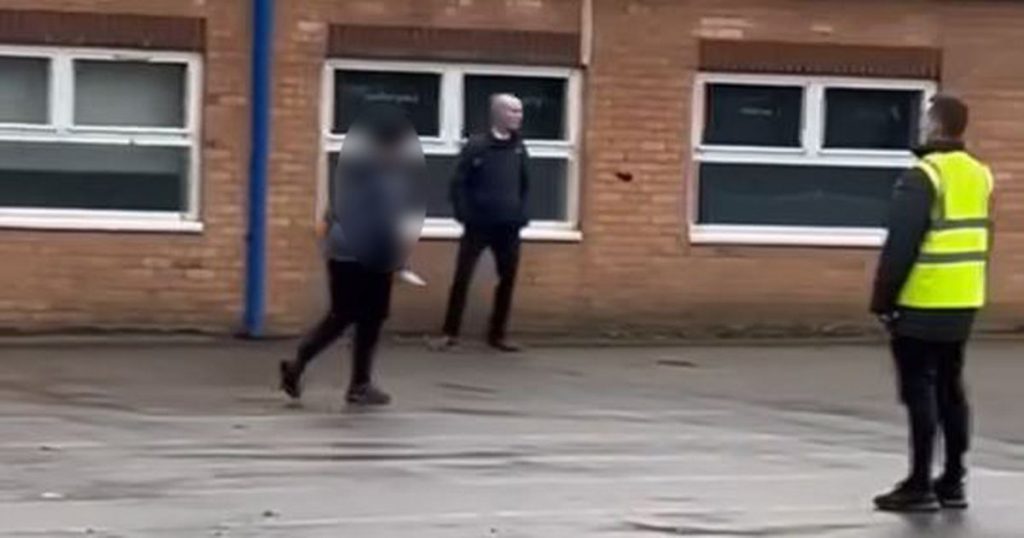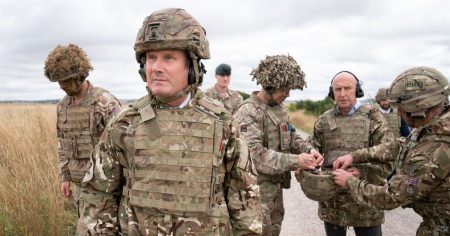###Incident Overview: A Troubling Scene in a School Playground
On Monday afternoon, a concerning incident unfolded in the playground of a school in Stockport, Greater Manchester. A 12-year-old boy was seen wielding a knife, prompting immediate action from authorities. The youngster, whose identity has not been disclosed due to his age, was subsequently arrested by police officers. This alarming event has sparked widespread concern among parents, educators, and the broader community, raising questions about safety, youth behavior, and the factors that may lead to such incidents.
The incident occurred during a time when students are typically engaged in recreational activities, making the presence of a knife in such a setting all the more disturbing. Authorities acted swiftly to ensure the safety of everyone involved, and the situation was brought under control without any reported injuries. However, the underlying causes of this behavior are now under scrutiny, as the community grapples with the reality of a young child being involved in such a serious matter.
### Community Reaction: Shock, Concern, and Calls for Action
The news of the 12-year-old boy being arrested for wielding a knife in a school playground has sent shockwaves through the community. Parents, in particular, are expressing deep concern about the safety of their children in what is supposed to be a secure and nurturing environment. Many are questioning how such an incident could occur and what measures are in place to prevent similar events in the future.
Educators and school administrators are also under the microscope, as the community seeks answers about how a young student came to possess a knife and why he chose to bring it to school. The incident has reignited debates about the role of schools in addressing behavioral issues and providing support to students who may be struggling with emotional or psychological challenges. Teachers and counselors are being called upon to identify early warning signs and intervene before situations escalate.
Local authorities have assured the public that they are taking the matter seriously and are working closely with the school to investigate the circumstances surrounding the incident. Parents have been urged to remain vigilant and to engage in open conversations with their children about the dangers of carrying weapons and the importance of resolving conflicts peacefully.
### The Implications for the Youngster and the Community
The arrest of a 12-year-old boy for possession of a knife in a school playground has significant implications for both the youngster and the community at large. At such a young age, the child is still developing emotionally and psychologically, and the factors that led to this behavior are likely to be complex and multifaceted. The incident raises important questions about the influences in the child’s life, including his home environment, peer relationships, and access to support systems.
From a legal perspective, the arrest of a minor introduces a range of challenges. The juvenile justice system is designed to focus on rehabilitation rather than punishment, but the seriousness of the offense may warrant a more stringent response. The courts will need to balance the need to hold the youngster accountable for his actions with the need to provide him with the support and resources necessary to address any underlying issues that may have contributed to his behavior.
The broader community is also impacted by this incident, as it highlights the need for a collective effort to address the root causes of such behavior. This includes not only the school and local authorities but also parents, community organizations, and mental health professionals. By working together, the community can create a safer and more supportive environment for all children.
### The Role of Schools in Preventing and Responding to Incidents
Schools play a critical role in preventing incidents like this and responding to them when they occur. In the wake of this event, educators and administrators are being called upon to review and strengthen their policies and procedures related to student safety and well-being. This includes not only measures to prevent weapons from entering the school but also initiatives to identify and support students who may be at risk of engaging in harmful behavior.
Schools are also being encouraged to foster a culture of openness and trust, where students feel comfortable seeking help and reporting concerns. This can involve both formal programs, such as counseling services and behavioral interventions, and informal efforts, such as building positive relationships between students and staff. By creating an environment where students feel supported and valued, schools can help to prevent incidents like this from occurring in the future.
In addition to these preventive measures, schools must also be prepared to respond effectively when incidents do occur. This includes having clear protocols in place for addressing and resolving conflicts, as well as for ensuring the safety of all students and staff. The response to this incident will serve as a test of the school’s ability to handle such situations and will likely influence how similar events are managed in the future.
### The Challenges Faced by Parents and Guardians
Parents and guardians are often the first line of defense when it comes to identifying and addressing behavioral issues in their children. However, they also face significant challenges in navigating these complex and sensitive matters. The arrest of a 12-year-old boy for wielding a knife in a school playground underscores the difficulties that parents may encounter in understanding and responding to their child’s behavior.
One of the key challenges for parents is recognizing the early warning signs of potential problems. This can be particularly difficult with young children, who may not always communicate their feelings or concerns openly. Parents must also contend with the pressures of modern life, including work, financial stress, and other family obligations, which can limit the time and resources they have to devote to their child’s well-being.
In addition to these challenges, parents must also navigate a complex system of resources and services designed to support children who are struggling. This can include everything from counseling and therapy to academic support and behavioral interventions. Parents who are unfamiliar with these systems may find it difficult to access the help their child needs, further complicating the situation.
### Moving Forward: Addressing the Root Causes and Building a Safer Future
Addressing the root causes of this incident and preventing similar events from occurring in the future will require a comprehensive and collaborative approach. This involves not only the school and local authorities but also parents, community organizations, and mental health professionals. By working together, the community can create a safer and more supportive environment for all children.
One of the key steps in this process is identifying and addressing the underlying factors that contributed to the youngster’s behavior. This may involve providing the child with access to counseling or other forms of support to help him manage his emotions and develop healthier coping strategies. It may also include working with his family to address any issues that may be impacting his behavior and well-being.
In addition to focusing on the individual child and his family, the community must also take a broader view of the problem. This includes examining the societal factors that may contribute to such behavior, such as access to weapons, exposure to violence, and the availability of mental health resources. By addressing these broader issues, the community can help to prevent similar incidents from occurring in the future and create a safer, more supportive environment for all children.












